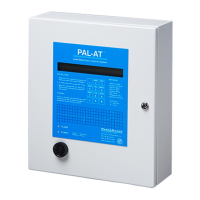3 Response to Alarms
36
Computer room subfloors, clean rooms, and pipe tunnels are good examples of accessible locations. The
simplest course of action for accessible locations is to check the location. Checking the location means
inspecting the sensor at the actual location, not just in the general vicinity.
Secondary contained piping and direct buried cable are examples of inaccessible locations. PAL-AT can
be used as a tool to gather data about the conditions in these areas. The type of sensor in the leak area
is important. All sensor cables change electrical properties as the fluid covers more of the sensor. Leaks
are characterized by an increasing amount of wet sensor. The sensor cables enable PAL-AT to provide
information about how fast a leak is spreading in inaccessible spaces. Probe sensors do not change
properties as more liquid covers the sensor. Instead, they act as a switch, either wet or dry.
3.2 Types of Alarm Conditions
PAL-AT detects several types of alarm conditions.
3.2.1 Fault
“Fault” is displayed if the alarm condition occurs in the first 50 ft [15 m] of the sensor string. Since the first
50 ft of sensor string is always jumper cable, there is no leak sensing capabilities (an exception is ATP
cable). Refer to the Troubleshooting Guide in section 5.6 for common procedures to help isolate the cause
of this alarm condition.
3.2.2 Break Alarm
When PAL-AT detects a “Break” condition, there is serious damage to the sensor string, a connector is
disconnected, or a connector is improperly installed. The message shows the distance to the break, so it
can be located on the system drawing.
3.2.3 Short Alarm
If the coaxial cable is shorted between the center conductor and the braid, PAL-AT detects a “Short”
condition. This can occur in a connector or if there is mechanical damage to the cable.
3.2.4 Drying or Probe Reset Alarm
When the cable dries or a probe resets following a leak event, the system detects “Drying” periodically.
This event does not produce audible alarms, but a new reference map is stored to maintain optimum
sensitivity and enable the system to continuously monitor the entire cable length.
3.2.5 Leak or Probe Activated Alarm
When PAL-AT locates a “Leak” or “Probe Activated” condition, it immediately creates a new reference map
to continue monitoring the entire sensing string. The system maintains an alarm queue until an authorized
person clears the queue.

